Sagittarius A*
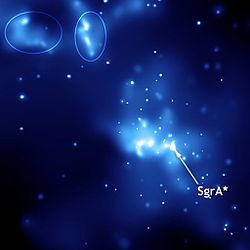 Sgr A* (center) and two light echoes from a recent explosion (circled) | |
| Observation data Epoch J2000 Equinox J2000 | |
|---|---|
Constellation | Sagittarius |
Right ascension | 17h 45m 40.0409s |
Declination | −29° 0′ 28.118″[1] |
| Details | |
| Mass | (4.31 ± 0.38) × 106[2]M☉ (4.1 ± 0.6) × 106[3]M☉ (4.02 ± 0.16) × 106[4] M☉ |
| Astrometry | |
| Distance | 7,860±140±40[4] pc |
| Database references | |
| SIMBAD | data |
Sagittarius A* (pronounced "Sagittarius A-star", standard abbreviation Sgr A*) is a bright and very compact astronomical radio source at the center of the Milky Way, near the border of the constellations Sagittarius and Scorpius. It is part of a larger astronomical feature known as Sagittarius A. Sagittarius A* is the location of a supermassive black hole,[5][6][7] like those that are now generally accepted to be at the centers of most if not all spiral and elliptical galaxies. Observations of a number of stars, most notably the star S2, orbiting around Sagittarius A* have been used to show the presence of, and produce data about, the Milky Way's central supermassive black hole, and have led to the conclusion that Sagittarius A* is the site of that black hole.[8]
Contents
1 Observation and description
2 History
3 Central black hole
4 Orbiting stars
5 Discovery of G2 gas cloud on an accretion course
6 See also
7 Notes
8 References
9 External links
Observation and description

ALMA observations of molecular-hydrogen-rich gas clouds.[9]
Astronomers have been unable to observe Sgr A* in the optical spectrum because of the effect of 25 magnitudes of extinction by dust and gas between the source and Earth.[10] Several teams of researchers have attempted to image Sagittarius A* in the radio spectrum using very-long-baseline interferometry (VLBI).[11] The current highest-resolution (approximately 30 μas) measurement, made at a wavelength of 1.3 mm, indicated an overall angular size for the source of 50μas.[12] At a distance of 26,000 light-years, this yields a diameter of 60 million kilometers. For comparison, Earth is 150 million kilometers from the Sun, and Mercury is 46 million kilometers from the Sun at perihelion. The proper motion of Sgr A* is approximately −2.70 mas per year for the right ascension and −5.6 mas per year for the declination.[13]
As of April 2017, there have been direct radio images taken of Sagittarius A* with the Event Horizon Telescope, but the data is still being processed, and images have yet to be released. The Event Horizon Telescope uses interferometry to combine images taken from widely spaced observatories at different places on Earth in order to gain a higher picture resolution. It is hoped the measurements will test Einstein's theory of relativity more rigorously than has previously been done. If discrepancies between the theory of relativity and actual observation are found, scientists may have identified physical circumstances under which the theory breaks down.[14]
History
Karl Jansky, considered a father of radio astronomy, discovered in August 1931 that a radio signal was coming from a location at the center of the Milky Way, in the direction of the constellation of Sagittarius.[15] Sgr A* was discovered on February 13 and 15, 1974, by astronomers Bruce Balick and Robert Brown using the baseline interferometer of the National Radio Astronomy Observatory.[16][17] The name Sgr A* was coined by Brown in a 1982 paper because the radio source was "exciting", and excited states of atoms are denoted with asterisks.[18][19]
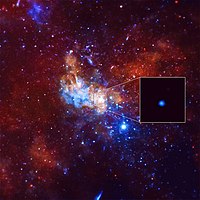
Detection of an unusually bright X-ray flare from Sgr A*[20]
On October 16, 2002, an international team led by Reinhard Genzel of the Max Planck Institute for Extraterrestrial Physics reported the observation of the motion of the star S2 near Sagittarius A* over a period of ten years. According to the team's analysis, the data ruled out the possibility that Sgr A* contains a cluster of dark stellar objects or a mass of degenerate fermions, strengthening the evidence for a massive black hole.[21] The observations of S2 used near-infra red (NIR) interferometry (in the K-band, i.e. 2.2 μm) because of reduced interstellar extinction in this band. SiO masers were used to align NIR images with radio observations, as they can be observed in both NIR and radio bands. The rapid motion of S2 (and other nearby stars) easily stood out against slower-moving stars along the line-of-sight so these could be subtracted from the images.
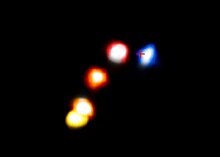
Dusty cloud G2 passes the supermassive black hole at the center of the Milky Way.[22]
The VLBI radio observations of Sagittarius A* could also be aligned centrally with the images so S2 could be seen to orbit Sagittarius A*. From examining the Keplerian orbit of S2, they determined the mass of Sagittarius A* to be 2.6 ± 0.2 million solar masses, confined in a volume with a radius no more than 17 light-hours (120 AU).[23] Later observations of the star S14 showed the mass of the object to be about 4.1 million solar masses within a volume with radius no larger than 6.25 light-hours (45 AU) or about 6.7 billion kilometres.[3] S175 passed within a similar distance.[24] For comparison, the Schwarzschild radius is 0.08 AU. They also determined the distance from Earth to the Galactic Center (the rotational center of the Milky Way), which is important in calibrating astronomical distance scales, as 8.0 ± 0.6 × 103parsecs. In November 2004 a team of astronomers reported the discovery of a potential intermediate-mass black hole, referred to as GCIRS 13E, orbiting three light-years from Sagittarius A*. This black hole of 1,300 solar masses is within a cluster of seven stars. This observation may add support to the idea that supermassive black holes grow by absorbing nearby smaller black holes and stars.
After monitoring stellar orbits around Sagittarius A* for 16 years, Gillessen et al. estimate the object's mass at 4.31 ± 0.38 million solar masses. The result was announced in 2008 and published in The Astrophysical Journal in 2009.[2]Reinhard Genzel, team leader of the research, said the study has delivered "what is now considered to be the best empirical evidence that super-massive black holes do really exist. The stellar orbits in the Galactic Center show that the central mass concentration of four million solar masses must be a black hole, beyond any reasonable doubt."[25]
On January 5, 2015, NASA reported observing an X-ray flare 400 times brighter than usual, a record-breaker, from Sgr A*. The unusual event may have been caused by the breaking apart of an asteroid falling into the black hole or by the entanglement of magnetic field lines within gas flowing into Sgr A*, according to astronomers.[20]
@media all and (max-width:720px){.mw-parser-output .tmulti>.thumbinner{width:100%!important;max-width:none!important}.mw-parser-output .tmulti .tsingle{float:none!important;max-width:none!important;width:100%!important;text-align:center}}
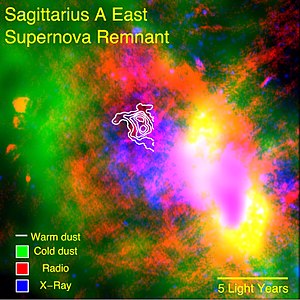
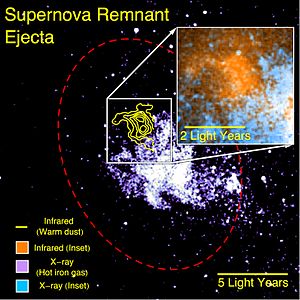
Supernova remnant ejecta producing planet-forming material
Central black hole
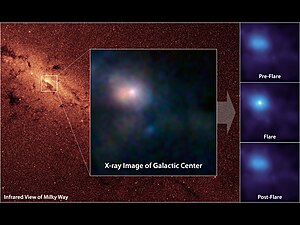
NuSTAR has captured these first, focused views of the supermassive black hole at the heart of the Milky Way in high-energy X-rays.
In a paper published October 31, 2018, the discovery of conclusive evidence that Sagittarius A* is a black hole was announced. Using the GRAVITY interferometer and the four telescopes of the Very Large Telescope (VLT) to create a virtual telescope 130 metres in diameter, astronomers detected clumps of gas moving at about 30% of the speed of light. Emission from highly energetic electrons very close to the black hole was visible as three prominent bright flares. These exactly match theoretical predictions for hot spots orbiting close to a black hole of four million solar masses. The flares are thought to originate from magnetic interactions in the very hot gas orbiting very close to Sagittarius A*.[26][27]
In July 2018, it was reported that S2 orbiting Sgr A* had been recorded at 7,650km/s or 2.55% the speed of light leading up to the pericentre approach, in May 2018, at about 120 AU ≈ 1400 Schwarzschild radii from Sgr A*. At that close distance to the black hole, Einstein's Theory of General Relativity predicts that S2 would show a discernible gravitational redshift in addition to the usual velocity redshift; the gravitational redshift was detected, in agreement with GR prediction within the 10 percent measurement precision.[28][29]
Assuming that general relativity is still a valid description of gravity near the event horizon then the Sagittarius A* radio emissions are not centered on the black hole, but arise from a bright spot in the region around the black hole, close to the event horizon, possibly in the accretion disc, or a relativistic jet of material ejected from the disc.[12] If the apparent position of Sagittarius A* were exactly centered on the black hole, it would be possible to see it magnified beyond its actual size, because of gravitational lensing of the black hole. According to general relativity, this would result in a ring-like structure, which has a diameter about 5.2 times the black hole's Schwarzschild radius. For a black hole of around 4 million solar masses, this corresponds to a size of approximately 52 μas, which is consistent with the observed overall size of about 50μas.[12]
Recent lower resolution observations revealed that the radio source of Sagittarius A * is symmetrical[30]. These results are at tension with General Relativity which if no other viable explanation is found within the general relativistic paradigm may demand a new theory of gravitation or modifications to General Relativity itself. Simulations of alternative theories of gravity depict results indistinguishable from GR. However a new paper predicts an image of Sagittarius A * which is in agreement with recent observations, in particular, it explains the small angular size and the symmetrical morphology of the source.
The mass of Sagittarius A* has been estimated in two different ways.
- Two groups—in Germany and the U.S.—monitored the orbits of individual stars very near to the black hole and used Kepler's laws to infer the enclosed mass. The German group found a mass of 4.31 ± 0.38 million solar masses,[2] whereas the American group found 3.7 ± 0.2 million solar masses.[3] Given that this mass is confined inside a 44 million km diameter sphere, this yields a density ten times higher than previous estimates.
- More recently, measurement of the proper motions of a sample of several thousand stars within approximately one parsec from the black hole, combined with a statistical technique, has yielded both an estimate of the black hole's mass at 7006360000000000000♠3.6+0.2
−0.4×106 M☉, plus a distributed mass in the central parsec amounting to 7006100000000000000♠(1±0.5)×106 M☉.[31] The latter is thought to be composed of stars and stellar remnants.
The comparatively small mass of this black hole, along with the low luminosity of the radio and infrared emission lines, imply that the Milky Way is not a Seyfert galaxy.[10]
Ultimately, what is seen is not the black hole itself, but observations that are consistent only if there is a black hole present near Sgr A*. In the case of such a black hole, the observed radio and infrared energy emanates from gas and dust heated to millions of degrees while falling into the black hole.[26] The black hole itself is thought to emit only Hawking radiation at a negligible temperature, on the order of 10−14kelvin.
Magnetar — SGR J1745-2900 |
|---|
 Magnetar found very close to the supermassive black hole, Sagittarius A*, at the center of the Milky Way galaxy |
The European Space Agency's gamma-ray observatory INTEGRAL observed gamma rays interacting with the nearby giant molecular cloud Sagittarius B2, causing X-ray emission from the cloud. The total luminosity from this outburst (L≈1,5×1039 erg/s) is estimated to be a million times stronger than the current output from Sgr A* and is comparable with a typical active galactic nucleus.[32][33] In 2011 this conclusion was supported by Japanese astronomers observing the Milky Way's center with the Suzaku satellite.[34]
Orbiting stars
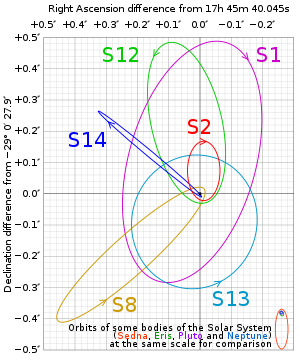
Inferred orbits of 6 stars around supermassive black hole candidate Sagittarius A* at the Milky Way's center[35]
| Star | Alias | a (") | a (AU) | e | P (years) | T0 (date) | Ref |
|---|---|---|---|---|---|---|---|
S1 | S0–1 | 0.412±0.024 | 3300±190 | 0.358±0.036 | 94.1±9.0 | 2002.6±0.6 | [35] |
S2 | S0–2 | 0.1226±0.0025 | 980±20 | 0.8760±0.0072 | 15.24±0.36 | 2002.315±0.012 | [35] |
| 919±23 | 0.8670±0.0046 | 14.53±0.65 | 2002.308±0.013 | [37] | |||
S8 | S0–4 | 0.329±0.018 | 2630±140 | 0.927±0.019 | 67.2±5.5 | 1987.71±0.81 | [35] |
S12 | S0–19 | 0.286±0.012 | 2290±100 | 0.9020±0.0047 | 54.4±3.5 | 1995.628±0.016 | [35] |
| 1720±110 | 0.833±0.018 | 37.3±3.8 | 1995.758±0.050 | [37] | |||
S13 | S0–20 | 0.219±0.058 | 1750±460 | 0.395±0.032 | 36±15 | 2006.1±1.4 | [35] |
S14 | S0–16 | 0.225±0.022 | 1800±180 | 0.9389±0.0078 | 38±5.7 | 2000.156±0.052 | [35] |
| 1680±510 | 0.974±0.016 | 36±17 | 2000.201±0.025 | [37] | |||
S0–102 | S0–102 | 0.68±0.02 | 11.5±0.3 | 2009.5±0.3 | [38] |
Discovery of G2 gas cloud on an accretion course
First noticed as something unusual in images of the center of the Milky Way in 2002,[39] the gas cloud G2, which has a mass about three times that of Earth, was confirmed to be likely on a course taking it into the accretion zone of Sgr A* in a paper published in Nature in 2012.[40] Predictions of its orbit suggested it would make its closest approach to the black hole (a perinigricon) in early 2014, when the cloud was at a distance of just over 3000 times the radius of the event horizon (or ≈260 AU, 36 light-hours) from the black hole. G2 has been observed to be disrupting since 2009,[40] and was predicted by some to be completely destroyed by the encounter, which could have led to a significant brightening of X-ray and other emission from the black hole. Other astronomers suggested the gas cloud could be hiding a dim star, or a binary star merger product, which would hold it together against the tidal forces of Sgr A*, allowing the ensemble to pass by without any effect.[41] In addition to the tidal effects on the cloud itself, it was proposed in May 2013[42] that, prior to its perinigricon, G2 might experience multiple close encounters with members of the black-hole and neutron-star populations thought to orbit near the Galactic Center, offering some insight into the region surrounding the supermassive black hole at the center of the Milky Way.[43]
The average rate of accretion onto Sgr A* is unusually small for a black hole of its mass[44] and is only detectable because it is so close to Earth. It was thought that the passage of G2 in 2013 might offer astronomers the chance to learn much more about how material accretes onto supermassive black holes. Several astronomical facilities observed this closest approach, with observations confirmed with Chandra, XMM, EVLA, INTEGRAL, Swift, Fermi and requested at VLT and Keck.[45]
Simulations of the passage were made before it happened by groups at ESO[46] and Lawrence Livermore National Laboratory (LLNL).[47]
As the cloud approached the black hole, Dr. Daryl Haggard said "It's exciting to have something that feels more like an experiment", and hoped that the interaction would produce effects that would provide new information and insights.[48]
Nothing was observed during and after the closest approach of the cloud to the black hole, which was described as a lack of "fireworks" and a "flop".[49] Astronomers from the UCLA Galactic Center Group published observations obtained on March 19 and 20, 2014, concluding that G2 was still intact (in contrast to predictions for a simple gas cloud hypothesis) and that the cloud was likely to have a central star.[50]
An analysis published on 21 July 2014 based on observations by the ESO's Very Large Telescope in Chile concluded alternatively that the cloud, rather than being isolated, might be a dense clump within a continuous but thinner stream of matter, and would act as a constant breeze on the disk of matter orbiting the black hole, rather than sudden gusts that would have caused high brightness as they hit, as originally expected. Supporting this hypothesis, G1, a cloud that passed near the black hole 13 years ago, had an orbit almost identical to G2, consistent with both clouds, and a gas tail thought to be trailing G2, all being denser clumps within a large single gas stream.[49][51]
Professor Andrea Ghez et al. suggested in 2014 that G2 is not a gas cloud but rather a pair of binary stars that had been orbiting the black hole in tandem and merged into an extremely large star.[41][52]
Sgr A* is monitored on a daily basis by the X-ray telescope of the Swift satellite.

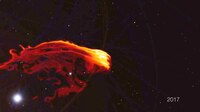 Play media
Play media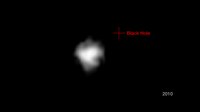 Play media
Play media
See also
- Center of the Andromeda Galaxy
- X-ray astronomy
Notes
^ Reid and Brunthaler 2004
^ abc Gillessen et al. 2009
^ abc Ghez, A. M.; et al. (December 2008). "Measuring Distance and Properties of the Milky Way's Central Supermassive Black Hole with Stellar Orbits". Astrophysical Journal. 689 (2): 1044–1062. arXiv:0808.2870. Bibcode:2008ApJ...689.1044G. doi:10.1086/592738..mw-parser-output cite.citation{font-style:inherit}.mw-parser-output .citation q{quotes:"""""""'""'"}.mw-parser-output .citation .cs1-lock-free a{background:url("//upload.wikimedia.org/wikipedia/commons/thumb/6/65/Lock-green.svg/9px-Lock-green.svg.png")no-repeat;background-position:right .1em center}.mw-parser-output .citation .cs1-lock-limited a,.mw-parser-output .citation .cs1-lock-registration a{background:url("//upload.wikimedia.org/wikipedia/commons/thumb/d/d6/Lock-gray-alt-2.svg/9px-Lock-gray-alt-2.svg.png")no-repeat;background-position:right .1em center}.mw-parser-output .citation .cs1-lock-subscription a{background:url("//upload.wikimedia.org/wikipedia/commons/thumb/a/aa/Lock-red-alt-2.svg/9px-Lock-red-alt-2.svg.png")no-repeat;background-position:right .1em center}.mw-parser-output .cs1-subscription,.mw-parser-output .cs1-registration{color:#555}.mw-parser-output .cs1-subscription span,.mw-parser-output .cs1-registration span{border-bottom:1px dotted;cursor:help}.mw-parser-output .cs1-ws-icon a{background:url("//upload.wikimedia.org/wikipedia/commons/thumb/4/4c/Wikisource-logo.svg/12px-Wikisource-logo.svg.png")no-repeat;background-position:right .1em center}.mw-parser-output code.cs1-code{color:inherit;background:inherit;border:inherit;padding:inherit}.mw-parser-output .cs1-hidden-error{display:none;font-size:100%}.mw-parser-output .cs1-visible-error{font-size:100%}.mw-parser-output .cs1-maint{display:none;color:#33aa33;margin-left:0.3em}.mw-parser-output .cs1-subscription,.mw-parser-output .cs1-registration,.mw-parser-output .cs1-format{font-size:95%}.mw-parser-output .cs1-kern-left,.mw-parser-output .cs1-kern-wl-left{padding-left:0.2em}.mw-parser-output .cs1-kern-right,.mw-parser-output .cs1-kern-wl-right{padding-right:0.2em}
^ ab Boehle, A; Ghez, A. M; Schödel, R; Meyer, L; Yelda, S; Albers, S; Martinez, G. D; Becklin, E. E; Do, T; Lu, J. R; Matthews, K; Morris, M. R; Sitarski, B; Witzel, G (2016-07-19). "An Improved Distance and Mass Estimate for Sgr A* from a Multistar Orbit Analysis". The Astrophysical Journal. 830 (1): 17. arXiv:1607.05726. Bibcode:2016ApJ...830...17B. doi:10.3847/0004-637X/830/1/17.
^ "Scientists find proof a black hole is lurking at the centre of our galaxy". Metro. 2018-10-31. Retrieved 2018-10-31.
^ "A 'mind-boggling' telescope observation has revealed the point of no return for our galaxy's monster black hole". The Middletown Press. 2018-10-31. Retrieved 2018-10-31.
^ Plait, Phil. "Astronomers see material orbiting a black hole *right* at the edge of forever". https://www.syfy.com/. Syfy Wire. Archived from the original on 10 November 2018. Retrieved 12 November 2018. External link in|website=(help)
^ Henderson, Mark (December 9, 2008). "Astronomers confirm black hole at the heart of the Milky Way". Times Online. Retrieved 2009-05-17.
^ "Cloudlets swarm around our local supermassive black hole". www.eso.org. Retrieved 22 October 2018.
^ ab Osterbrock and Ferland 2006, p. 390
^ Falcke H, Melia F, Agol E (2000). "Viewing the Shadow of the Black Hole at the Galactic Center". Astrophysical Journal Letters. 528 (1): L13–L16. arXiv:astro-ph/9912263. Bibcode:2000ApJ...528L..13F. doi:10.1086/312423. PMID 10587484.
^ abc R. Lu et al. 2018. “Detection of intrinsic source structure at ~3 Schwarzschild radii with Millimeter-VLBI observations of Sgr A*.” ApJ, 859, 1, Pp. 60.
^ Backer and Sramek 1999, § 3
^ "Astronomers May Finally Have the First Picture of a Black Hole", 11 Apr 2017 National Geographic
^ "Karl Jansky: The Father of Radio Astronomy". Retrieved 2015-10-21.
^ Balick, B.; Brown, R. L. (1 December 1974). "Intense sub-arcsecond structure in the galactic center". Astrophysical Journal. 194 (1): 265–270. Bibcode:1974ApJ...194..265B. doi:10.1086/153242.CS1 maint: Multiple names: authors list (link)
^ Melia 2007, p. 7
^ Goss, W. M; Brown, Robert L; Lo, K. Y (2003-05-06). "[astro-ph/0305074] The Discovery of Sgr A*". Astronomische Nachrichten. 324 (1): 497. arXiv:astro-ph/0305074. Bibcode:2003ANS...324..497G. doi:10.1002/asna.200385047.
^ "Precessing jets in Sagittarius A – Gas dynamics in the central parsec of the galaxy", R. L. Brown, Astrophysical Journal, Part 1, 262, Nov. 1, 1982, pp. 110–119, Bibcode: 1982ApJ...262..110B.
^ ab Chou, Felicia; Anderson, Janet; Watzke, Megan (January 5, 2015). "RELEASE 15-001 – NASA's Chandra Detects Record-Breaking Outburst from Milky Way's Black Hole". NASA. Retrieved January 6, 2015.
^ Schödel et al. 2002
^ "Best View Yet of Dusty Cloud Passing Galactic Centre Black Hole". Retrieved 16 June 2015.
^ Ghez et al. 2003
^ Gillessen, S.; Plewa, P. M.; Eisenhauer, F.; Sari, R.; Waisberg, I.; Habibi, M.; Pfuhl, O.; George, E.; Dexter, J. (2017). "An Update on Monitoring Stellar Orbits in the Galactic Center". The Astrophysical Journal. 837 (1): 30. arXiv:1611.09144. Bibcode:2017ApJ...837...30G. doi:10.3847/1538-4357/aa5c41. ISSN 0004-637X.
^ O'Neill 2008
^ ab Abuter, R.; Amorim, A.; Bauböck, M.; Berger, J. P.; Bonnet, H.; Brandner, W.; Clénet, Y.; Coudé Du Foresto, V.; De Zeeuw, P. T.; Deen, C.; Dexter, J.; Duvert, G.; Eckart, A.; Eisenhauer, F.; Förster Schreiber, N. M.; Garcia, P.; Gao, F.; Gendron, E.; Genzel, R.; Gillessen, S.; Guajardo, P.; Habibi, M.; Haubois, X.; Henning, Th.; Hippler, S.; Horrobin, M.; Huber, A.; Jiménez-Rosales, A.; Jocou, L.; et al. (2018). "Detection of orbital motions near the last stable circular orbit of the massive black hole SgrA". Astronomy & Astrophysics. 618: L10. arXiv:1810.12641. Bibcode:2018A&A...618L..10G. doi:10.1051/0004-6361/201834294.
^ "Most Detailed Observations of Material Orbiting close to a Black Hole". European Southern Observatory (ESO). Retrieved 1 November 2018.
^ Detection of the gravitational redshift in the orbit of the star S2 near the Galactic centre massive black hole, Genzel et al, Astronomy & Astrophysics, DOI doi:10.1051/0004-6361/201833718, 2018-07-26
^ Star spotted speeding near black hole at centre of Milky Way -- Chile’s Very Large Telescope tracks S2 star as it reaches mind-boggling speeds by supermassive black hole, The Guardian, 2017-07-26
^ Issaoun, S. (January 18, 2019). "The Size, Shape, and Scattering of Sagittarius A* at 86 GHz: First VLBI with ALMA". arxiv. doi:10.3847/1538-4357/aaf732. Retrieved February 5, 2009.
^ Schödel et al. 2009
^ "Integral rolls back history of Milky Way's super-massive black hole". Hubble News Desk. January 28, 2005. Retrieved 2007-10-31.
^ M. G. Revnivtsev; et al. (2004). "Hard X-ray view of the past activity of Sgr A* in a natural Compton mirror". Astronomy and Astrophysics. 425 (3): L49–L52. arXiv:astro-ph/0408190. Bibcode:2004A&A...425L..49R. doi:10.1051/0004-6361:200400064.
^ M. Nobukawa; et al. (2011). "New Evidence for High Activity of the Supermassive Black Hole in our Galaxy". The Astrophysical Journal Letters. 739 (2): L52. arXiv:1109.1950. Bibcode:2011ApJ...739L..52N. doi:10.1088/2041-8205/739/2/L52.
^ abcdefg Eisenhauer, F.; et al. (July 20, 2005). "SINFONI in the Galactic Center: Young Stars and Infrared Flares in the Central Light-Month". The Astrophysical Journal. 628 (1): 246–259. arXiv:astro-ph/0502129. Bibcode:2005ApJ...628..246E. doi:10.1086/430667.
^ "Orbital Parameters of Stars Orbiting Sgr A*". The Astrophysics Spectator (4.10). July 11, 2007.
^ abc Ghez, A. M.; Salim, S.; Hornstein, S. D.; Tanner, A.; Lu, J. R.; Morris, M.; Becklin, E. E.; Duchêne, G. (May 2005). "Stellar Orbits around the Galactic Center Black Hole". The Astrophysical Journal. 620 (2): 744–757. arXiv:astro-ph/0306130. Bibcode:2005ApJ...620..744G. doi:10.1086/427175.
^ Meyer, L.; Ghez, A. M.; Schödel, R.; Yelda, S.; Boehle, A.; Lu, J. R.; Do, T.; Morris, M. R.; Becklin, E. E.; Matthews, K. (4 October 2012). "The Shortest Known Period Star Orbiting our Galaxy's Supermassive Black Hole". Science. 338 (6103): 84–87. arXiv:1210.1294. Bibcode:2012Sci...338...84M. doi:10.1126/science.1225506. PMID 23042888.
^ Matson, John (2012-10-22). "Gas Guzzler: Cloud Could Soon Meet Its Demise in Milky Way's Black Hole". Scientific American. Retrieved 2012-10-30.
^ ab Gillessen, S.; Genzel; Fritz; Quataert; Alig; Burkert; Cuadra; Eisenhauer; Pfuhl; Dodds-Eden; Gammie; Ott (5 January 2012). "A gas cloud on its way towards the supermassive black hole at the Galactic Centre". Nature. 481 (7379): 51–54. arXiv:1112.3264. Bibcode:2012Natur.481...51G. doi:10.1038/nature10652. PMID 22170607.
^ ab Witzel, G.; Ghez, A. M.; Morris, M. R.; Sitarski, B. N.; Boehle, A.; Naoz, S.; Campbell, R.; Becklin, E. E.; G. Canalizo; Chappell, S.; Do, T.; Lu, J. R.; Matthews, K.; Meyer, L.; Stockton, A.; Wizinowich, P.; Yelda, S. (1 January 2014). "Detection of Galactic Center Source G2 at 3.8 μm during Periapse Passage". Astrophysical Journal Letters. 796 (1): L8. arXiv:1410.1884. Bibcode:2014ApJ...796L...8W. doi:10.1088/2041-8205/796/1/L8 – via Institute of Physics.
^ Bartos, Imre; Haiman, Zoltán; Kocsis, Bence; Márka, Szabolcs (May 2013). "Gas Cloud G2 Can Illuminate the Black Hole Population Near the Galactic Center". Physical Review Letters. 110 (22): 221102 (5 pages). arXiv:1302.3220. Bibcode:2013PhRvL.110v1102B. doi:10.1103/PhysRevLett.110.221102. PMID 23767710.
^ de la Fuente Marcos, R.; de la Fuente Marcos, C. (August 2013). "Colliding with G2 near the Galactic Centre: a geometrical approach". Monthly Notices of the Royal Astronomical Society: Letters. 435 (1): L19–L23. arXiv:1306.4921. Bibcode:2013MNRAS.435L..19D. doi:10.1093/mnrasl/slt085.
^ Morris, Mark (4 January 2012). "Astrophysics: The Final Plunge". Nature. 481 (7379): 32–33. Bibcode:2012Natur.481...32M. doi:10.1038/nature10767. PMID 22170611.
^ Gillessen. "Wiki Page of Proposed Observations of G2 Passage". Retrieved 30 October 2012.
^ "A Black Hole's Dinner is Fast Approaching". ESO. 2011-12-14. Retrieved 2015-02-27.
^ Robert H Hirschfeld (2012-10-22). "Milky Way's black hole getting ready for snack". [www.Llnl.gov Lawrence Livermore National Laboratory]. Retrieved 2015-02-27.
^ space.com, Doomed Space Cloud Nears Milky Way's Black Hole as Scientists Watch, 28 April 2014 "Cosmic encounter that might reveal new secrets on how such supermassive black holes evolve"; "We get to watch it unfolding in a human lifetime, which is very unusual and very exciting"
^ ab Cowen, Ron (2014). "Why galactic black hole fireworks were a flop : Nature News & Comment". Nature. doi:10.1038/nature.2014.15591. Retrieved 2015-02-27.
^ A. M. Ghez; G . Witzel; B. Sitarski; L. Meyer; S. Yelda; A. Boehle; E. E. Becklin; R. Campbell; G. Canalizo; T. Do; J. R. Lu; K. Matthews; M. R. Morris; A. Stockton (2 May 2014). "Detection of Galactic Center Source G2 at 3.8 micron during Periapse Passage Around the Central Black Hole". The Astronomer's Telegram (6110). Retrieved May 3, 2014.
^ Pfuhl, Oliver; Gillessen, Stefan; Eisenhauer, Frank; Genzel, Reinhard; Plewa, Philipp M.; Thomas Ott; Ballone, Alessandro; Schartmann, Marc; Burkert, Andreas (2015). "The Galactic Center Cloud G2 and its Gas Streamer". The Astrophysical Journal. 798 (2): 111. arXiv:1407.4354. Bibcode:2015ApJ...798..111P. doi:10.1088/0004-637x/798/2/111. ISSN 0004-637X.
^ "How G2 survived the black hole at our Milky Way's heart - EarthSky.org".
^ "Simulation of gas cloud after close approach to the black hole at the centre of the Milky Way". ESO. Retrieved 2015-02-27.
References
Melia, Fulvio (2003). The Black Hole at the Center of our Galaxy. Princeton: Princeton University Press. ISBN 978-0691095059.
Backer, D. C. & Sramek, R. A. (20 October 1999). "Proper Motion of the Compact, Nonthermal Radio Source in the Galactic Center, Sagittarius A*". The Astrophysical Journal. 524 (2): 805–815. arXiv:astro-ph/9906048. Bibcode:1999ApJ...524..805B. doi:10.1086/307857.
Doeleman, Sheperd; et al. (4 September 2008). "Event-horizon-scale structure in the supermassive black hole candidate at the Galactic Centre". Nature. 455 (7209): 78–80. arXiv:0809.2442. Bibcode:2008Natur.455...78D. doi:10.1038/nature07245. PMID 18769434.
Eckart, A.; Schödel, R.; Straubmeier, C. (2005). The Black Hole at the Center of the Milky Way. London: Imperial College Press.
Eisenhauer, F.; et al. (23 October 2003). "A Geometric Determination of the Distance to the Galactic Center". The Astrophysical Journal. 597 (2): L121–L124. arXiv:astro-ph/0306220. Bibcode:2003ApJ...597L.121E. doi:10.1086/380188.
Ghez, A. M.; et al. (12 March 2003). "The First Measurement of Spectral Lines in a Short-Period Star Bound to the Galaxy's Central Black Hole: A Paradox of Youth". The Astrophysical Journal. 586 (2): L127–L131. arXiv:astro-ph/0302299. Bibcode:2003ApJ...586L.127G. doi:10.1086/374804.
Ghez, A. M.; et al. (December 2008). "Measuring Distance and Properties of the Milky Way's Central Supermassive Black Hole with Stellar Orbits". Astrophysical Journal. 689 (2): 1044–1062. arXiv:0808.2870. Bibcode:2008ApJ...689.1044G. doi:10.1086/592738.
Gillessen, Stefan; et al. (23 February 2009). "Monitoring stellar orbits around the Massive Black Hole in the Galactic Center". The Astrophysical Journal. 692 (2): 1075–1109. arXiv:0810.4674. Bibcode:2009ApJ...692.1075G. doi:10.1088/0004-637X/692/2/1075.
Melia, Fulvio (2007). The Galactic Supermassive Black Hole. Princeton: Princeton University Press. ISBN 978-0-691-13129-0.
O'Neill, Ian (10 December 2008). "Beyond Any Reasonable Doubt: A Supermassive Black Hole Lives in Centre of Our Galaxy". Universe Today.
Osterbrock, Donald E. & Ferland, Gary J. (2006). Astrophysics of Gaseous Nebulae and Active Galactic Nuclei (2nd ed.). University Science Books. ISBN 978-1-891389-34-4.
Reid, M.J.; Brunthaler, A. (2004). "Sgr A* – Radio-source". Astrophysical Journal. 616 (2): 872–884. arXiv:astro-ph/0408107. Bibcode:2004ApJ...616..872R. doi:10.1086/424960.
Reynolds, C. (4 September 2008). "Astrophysics: Bringing black holes into focus". Nature. 455 (7209): 39–40. Bibcode:2008Natur.455...39R. doi:10.1038/455039a. PMID 18769426.
Schödel, R.; et al. (17 October 2002). "A star in a 15.2-year orbit around the supermassive black hole at the centre of the Milky Way". Nature. 419 (6908): 694–696. arXiv:astro-ph/0210426. Bibcode:2002Natur.419..694S. doi:10.1038/nature01121. PMID 12384690.
Schödel, R.; Merritt, D.; Eckart, A. (July 2009). "The nuclear star cluster of the Milky Way: Proper motions and mass". Astronomy and Astrophysics. 502 (1): 91–111. arXiv:0902.3892. Bibcode:2009A&A...502...91S. doi:10.1051/0004-6361/200810922.
Wheeler, J. Craig (2007). Cosmic Catastrophes: Exploding Stars, Black Holes, and Mapping the Universe (2nd ed.). Cambridge, UK: Cambridge University Press. ISBN 978-0-521-85714-7.
External links
| Wikimedia Commons has media related to Sagittarius A. |
UCLA Galactic Center Group – latest results retrieved 8/12/2009- Is there a Supermassive Black Hole at the Center of the Milky Way? (arxiv preprint)
- 2004 paper deducing mass of central black hole from orbits of 7 stars (arxiv preprint)
ESO video clip of orbiting star (533 KB MPEG Video)
The Proper Motion of Sgr A* and the Mass of Sgr A* (PDF)
NRAO article regarding VLBI radio imaging of Sgr A*
Peering into a Black Hole, New York Times video 2015

